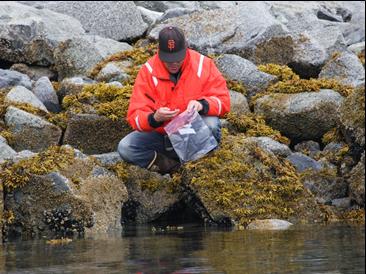How clean are the park’s marine waters?
Project Dates
Ongoing since 2007
Did You Know?
Mussels inhale water slowly and exhale it rapidly through separate siphons. By squirting the exhaled water away from itself, the mussel avoids inhaling water that has already been filtered. A mussel can filter 6-9 liters of water per hour.
What is SEAN?
The Southeast Alaska Inventory and Monitoring Network (SEAN) is one of 32 networks across the United States that further NPS efforts to improve park management through greater reliance on scientific information. SEAN supports the three national park units in Southeast Alaska (Glacier Bay, Sitka and Klondike Gold Rush); its offices are located in Juneau. The Inventory and Monitoring Program designs and implements long-term ecological monitoring and provides results to park managers, science partners, and the public. The intent is to provide periodic assessments of critical resources to evaluate the integrity of park ecosystems and better understand ecosystem processes.
Introduction

Because contaminants such as heavy metals and fuel are a threat to pristine marine ecosystems, SEAN selected marine contaminants as one of 12 core vital signs to be monitored. The monitoring program reveals important links between oceanic and atmospheric systems and demonstrates the effects of climate change and other anthropogenic influences on oceanic systems.
Bay mussels, which are sessile filter feeders in the intertidal zone and live up to 20 years, were chosen as the “contaminants samplers” for this study. As mussels feed, any contaminants in the water are incorporated into their tissues and in some cases accumulate there. Analysis of their tissues can therefore reveal chronic (over time) as well as acute (immediate, point-source) contamination threats. Laboratory analysis can detect hydrocarbons, organic pollutants such as pesticides, and heavy metals such as mercury in mussel tissues.
This project is part of a larger effort to monitor the condition of marine waters in the national parks of Southeast Alaska. The objectives of the program are to track status and trends of contaminant levels over time and to provide a regularly updated reference data set that will be invaluable in the event of an acute contamination event, such as a chemical or fuel spill in these well-traveled waters.
Methods
Bay mussel samples were collected from 65 sites for the initial assessment in 2007.
Beginning in 2009, SEAN has conducted regular, biennial sampling at five sites in Glacier Bay: east of Russell Island, upper Tarr Inlet, Ripple Cove, Bartlett Cove, and lower Excursion Inlet. During years 2013, 2015, and 2017, each site will be visited in August or early September. At each site, 80 mussels greater than 1.25 cm or 160 mussels less than 1.25 cm will be collected at low tide and temporarily stored in coolers prior to shipping to the laboratory.
The time, water temperature, height of collection above the current water level, GPS location, and the height of the highest mussel distribution relative to water level will be noted. Small vials of seawater will be collected for future salinity analysis. All samples will be sent to certified laboratories for contaminants analysis.
SEAN formally joined the National Oceanic and Atmospheric Administration (NOAA) Mussel Watch program in 2013. Mussel Watch is a national, long-running marine contaminant monitoring effort begun by NOAA in 1986. SEAN staff will collect and prepare samples for submittal to the national system, thus allowing local data to be incorporated into an existing national database.
Findings
Results from the initial assessment show that the intertidal areas of Glacier Bay are pristine and generally have lower levels of contamination than most sites in the lower 48. All but a few samples had very low levels of contamination, and the samples with higher levels came from targeted areas near potential point sources of pollution (i.e., “hot controls” at boat harbors and fueling docks).
For Southeast Alaska parks generally, the results of the initial assessment show that marine contaminant levels are low and are primarily attributable to local rather than regional or global sources.
Learn More
“Contaminants Assessment of Intertidal Resources in Southeast Alaska National Parks—2007 to 2011” by David Tallmon, UAS. This report and much more information is available at the SEAN website.
Last updated: October 31, 2016
